SECTION I
TIME: 60 MINUTES
80 MULTIPLE-CHOICE QUESTIONS
DIRECTIONS: Answer the multiple-choice questions below. Some are based on images. In this book the illustrations are at the top of each set of questions. Select the multiple-choice response that best completes each statement or question. You will have 60 minutes to answer the multiple-choice questions.
Questions 1–3 are based on Figures 1 and 2.
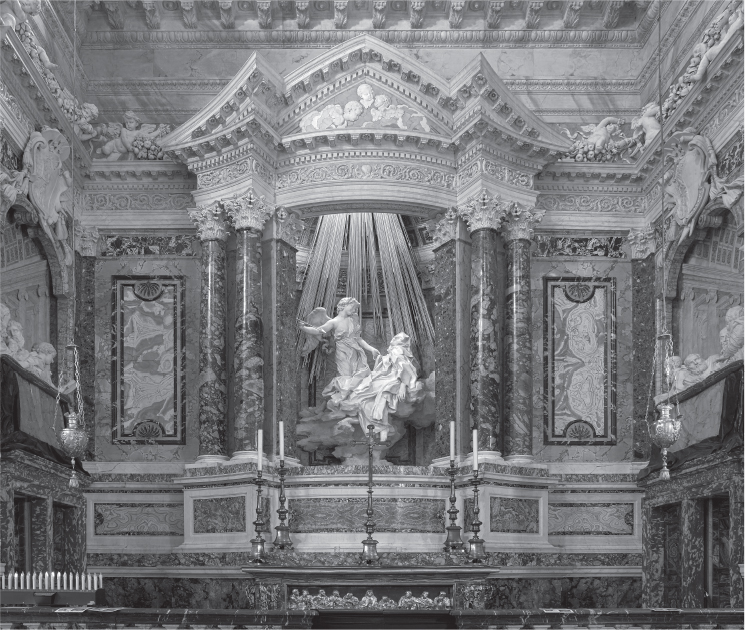
Figure 1
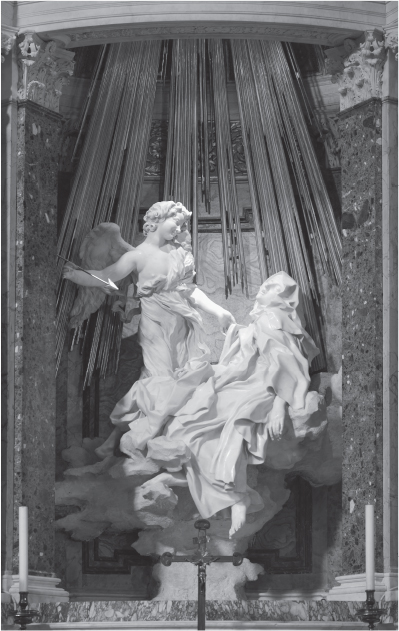
Figure 2
1.Gianlorenzo Bernini drew inspiration for this work from his experience as a
(A)writer of religious texts
(B)friend of Saint Teresa
(C)priest
(D)stage designer
2.Baroque works such as these have an emotional realism that takes inspiration from
(A)Hellenistic Greece
(B)Benin Africa
(C)Mongol India
(D)Romanesque Europe
3.The patrons of the work were the Cornaro family of Rome
(A)who objected to the work and wanted it removed
(B)whose names are inscribed on the sculpture
(C)who built the church and the sculptures in it
(D)whose portraits are visible in the chapel
Questions 4–6 are based on Figure 3.
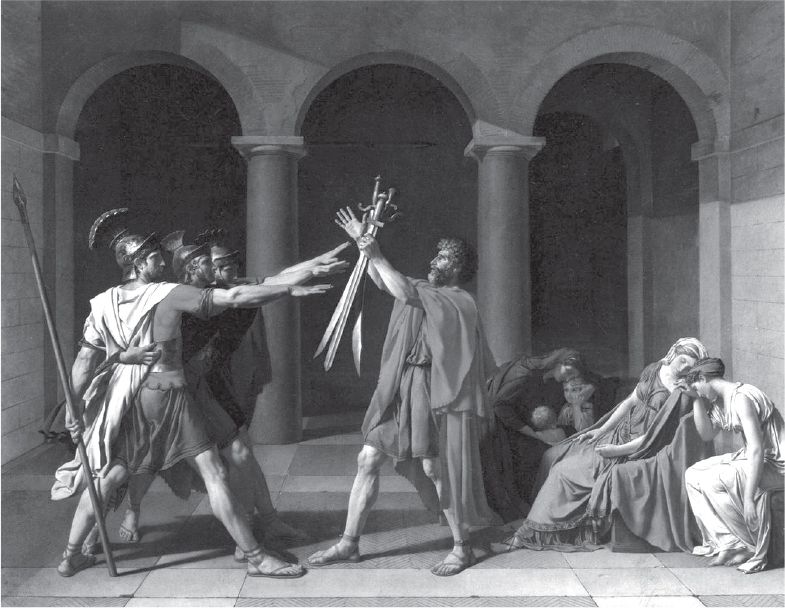
Figure 3
4.The formal qualities of this work identify it as an example of
(A)Neoclassicism, because of the great attention to classical forms
(B)Romanticism, because of the emotional content of the work and its vibrant brushwork
(C)Rococo, because of the light color palette
(D)Impressionism, because of the great attention to the effects of light and air on the subject
5.The themes used to create this work demonstrate the influence of
(A)Renaissance epics
(B)Russian literature
(C)medieval folktales
(D)ancient Roman legends
6.The work can be interpreted to mean
(A)sacrifice for one’s country is a noble cause
(B)revolutions are necessary when governments fail to respond to the needs of the hungry and destitute
(C)religious suppression cannot be tolerated in a free society
(D)Papal authority needs to be questioned in an era of reform
Questions 7–10 are based on Figure 4.
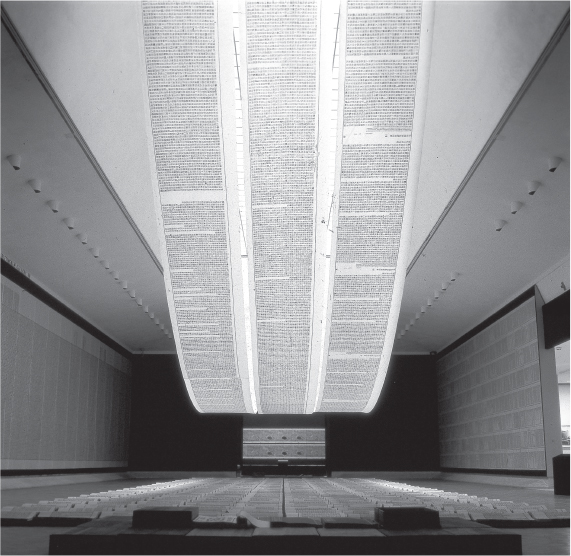
Figure 4
7.This work is inspired by traditional wood-block print technology known in
(A)India
(B)Colonial Latin America
(C)Southeast Asia
(D)China
8.Many of the characters used in this work
(A)are the invention of the artist and have no meaning
(B)are antigovernment and a cause for political scandal
(C)signify progressive attitudes toward family and relationships and therefore caused censure
(D)are inked upside-down and cause viewer confusion
9.The artist of this work draws upon influence from other cultures like
(A)New World symbolism and iconography
(B)French Impressionist painting and printmaking
(C)African rites and rituals
(D)contemporary mass production and commercialism
10.The artist drew criticism for this work because
(A)the importation of foreign materials into the United States without a permit was against the law
(B)the Communist government thought it held secret subversive ideas
(C)the content of the work was viewed as shocking and pornographic
(D)it became a center of religious worship
Question 11 is based on Figure 5.

Figure 5
11.This work can be attributed to which of the following periods in art history?
(A)Archaic Greek
(B)Imperial Roman
(C)Persian
(D)Egyptian New Kingdom
Questions 12–15 are based on Figures 6 and 7.
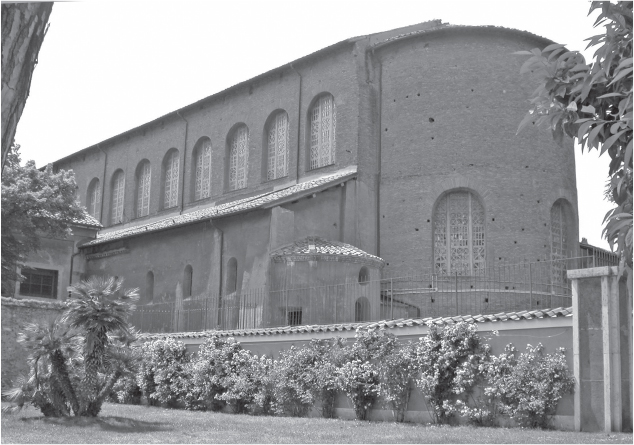
Figure 6
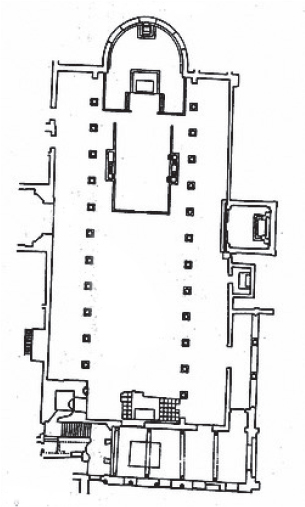
Figure 7
12.This Christian building was probably influenced by buildings such as the
(A)Catacombs of Priscilla
(B)Pantheon
(C)Basilica of Ulpia
(D)Temple of Amen-Re
13.The building has spolia, which are
(A)the spoils of war
(B)new types of stained glass having a multicolored effect
(C)the reuse of architectural elements from other sites
(D)permanently placed fountains, impluvia, and other water-based features
14.The ground plan indicates that this building is
(A)a basilica with a focus on an apse
(B)a combination of centrally planned and axially planned building formats
(C)built over a sacred spot
(D)constructed with a transept for clergy
15.The congregation in this building
(A)acts independently and prays separately
(B)worships together as they face the apse
(C)worships together as they face a holy shrine
(D)acts independently as they take turns circumambulating the altar
Question 16 is based on Figure 8.
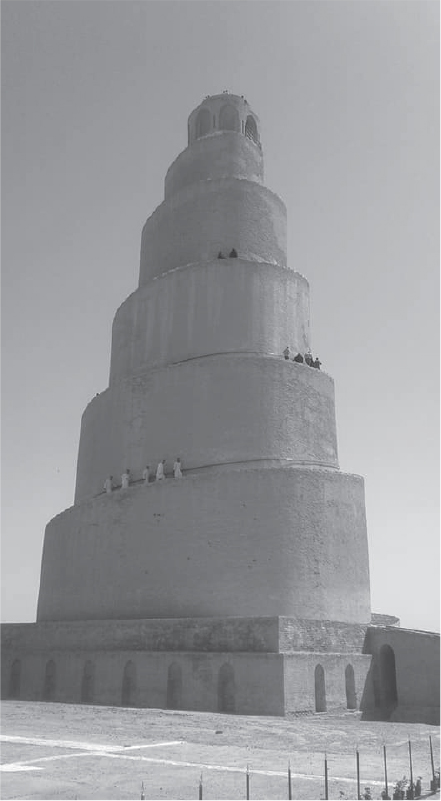
Figure 8
16.The function of this structure was to
(A)ring bells to summon the faithful to church, as in a bell tower
(B)be a look-out tower for defense purposes, as in a fortress
(C)create a monument to the glory of a ruler, as in a tomb
(D)signal a time to pray, as in a minaret
Questions 17–20 are based on Figure 9.
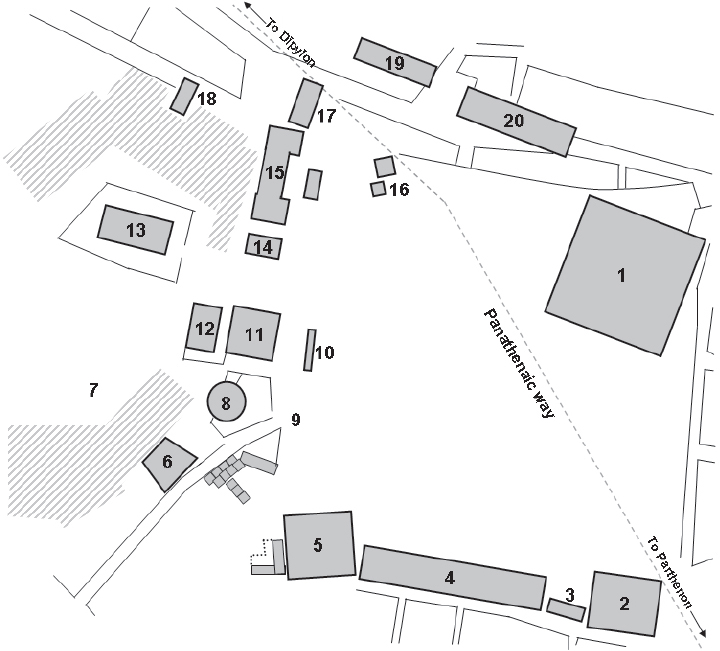
Figure 9
17.The function of the Athenian agora was to
(A)give athletes space to exercise
(B)create laws and conduct business
(C)defend the city against invaders
(D)hold a council with all the gods
18.The Panathenaic Way, which runs through the agora, was used for
(A)the Olympics
(B)secret diplomatic missions
(C)sacred processions
(D)shipping and commerce
19.A stoa is a
(A)circular shrine with surrounding columns
(B)meeting place set aside for the gods
(C)prison for traitors to Athens
(D)place of business and commerce
20.The Panathenaic Procession is similar to the imagery displayed on
(A)the Great Altar of Zeus and Athena at Pergamon
(B)Bayeux Tapestry
(C)Great Zimbabwe
(D)Presentation of Fijian mats and tapa cloths to Queen Elizabeth II
21.Which of the following statements is true about both the Pazzi Chapel and the Palazzo Rucellai?
(A)They are both concerned with the soaring spiritual nature that architecture is capable of.
(B)They both rely on Renaissance principles of proportion, measurement, and balance.
(C)They both were commissioned by the same patrons in Florence.
(D)They both were built as subsidiary buildings to the main building next to them.
22.Which of the following aspects of ancient Greek beliefs is reflected in the sculptural program of the Parthenon?
(A)The gods are removed from earthly concerns and rarely interact with humans.
(B)Humans are seen in subservient roles submitting before powerful gods.
(C)Greek gods often challenged and contended with one another for dominance.
(D)Ordinary humans, through hard work and sacrifice, could become gods themselves.
23.A pilgrim progressing through the Great Stupa at Sanchi is meant to worship by
(A)walking clockwise in the direction of the sun’s course
(B)climbing to the top, to symbolize conquering of earthly pleasures and sins
(C)kneeling facing East, in the direction of sunrise
(D)offering sacrifices to the Buddha by placing offerings at the base of this monument
Question 24 is based on Figure 10.

Figure 10
24.The ground plan of San Vitale indicates that the architects wanted the structure to appear to be influenced by
(A)Greek temple designs, such as the Parthenon
(B)Egyptian temple designs, such as the Temple of Amen-Re
(C)Early Christian designs, such as the church of Santa Sabina
(D)Roman temple designs, such as the temple of the Pantheon
25.Often sacred monuments show a mixture of two religions when they are originally designed. Which of the following monuments was built with two faiths in mind?
(A)Lakshmana Temple
(B)San Carlo alle Quattro Fontane
(C)The Parthenon
(D)Angkor Wat
Questions 26–28 are based on Figures 11 and 12.
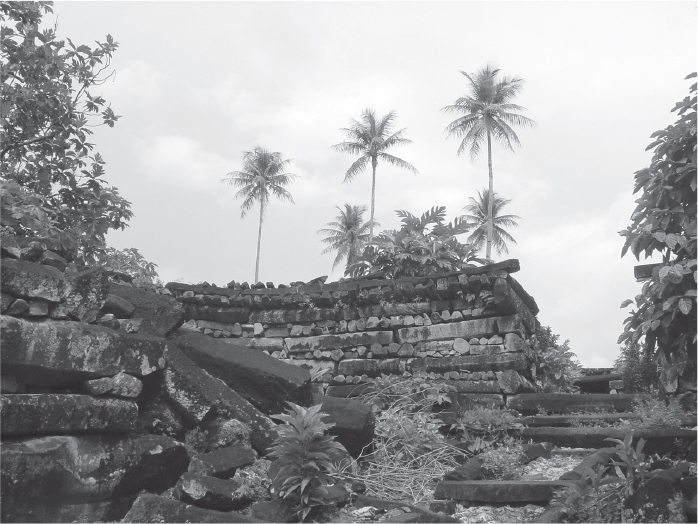
Figure 11

Figure 12
26.The location of Nan Madol is meant to
(A)have a private enclosure for prayer and worship
(B)simulate trade and growth among merchants in the kingdom
(C)ensure prosperity of the country
(D)bring the nobles to live in one place
27.The exterior walls of the complex serve the practical function of
(A)allowing ample space for storage
(B)ensuring a proper fresh water supply
(C)giving the king a private set of quarters to live in
(D)being a water break against waves that might strike the complex
28.This complex is unusual in Polynesian societies because it
(A)is made of stone
(B)is surrounded by water
(C)is on a small island
(D)contains a religious center
Questions 29 and 30 are based on Figure 13.
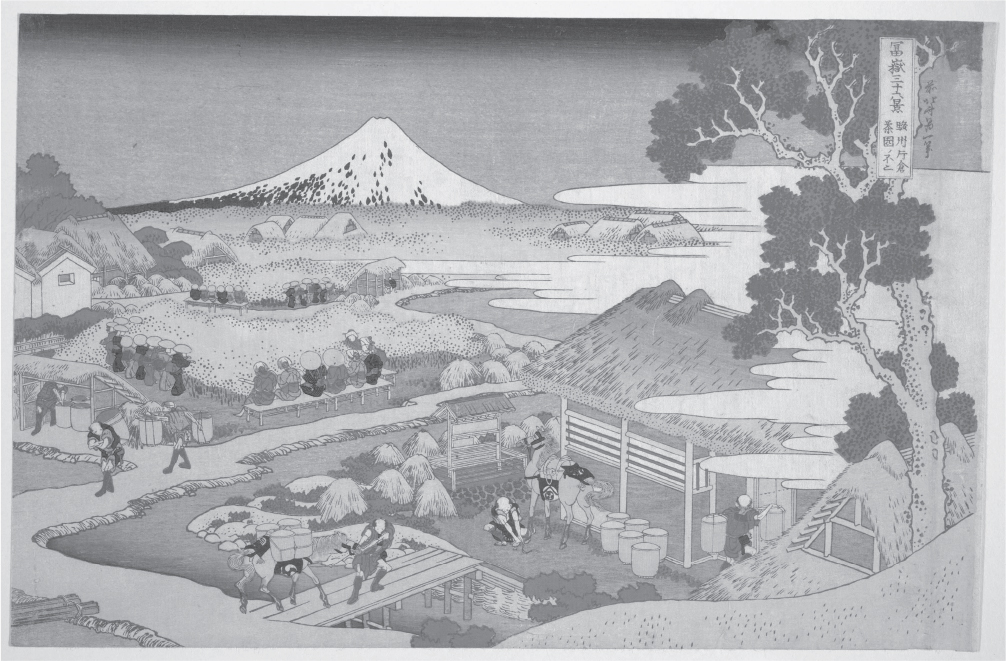
Figure 13
29.This work was done in which of the following techniques?
(A)Wood-block printing
(B)Lithography
(C)Etching
(D)Watercolor
30.This work is done in a tradition known as
(A)Yamato-e
(B)Tarashikomi
(C)Zen
(D)Ukiyo-e
Questions 31–33 refer to Figures 14 and 15.
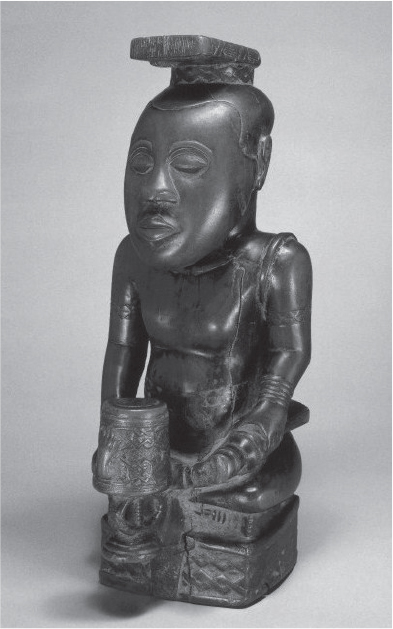
Figure 14

Figure 15
31.Ndop sculptures are characterized by
(A)a face that seems uninvolved, above mortal affairs
(B)anatomical proportions that emphasize the feet as stabilizing the sculpture
(C)elaborate costumes that symbolize the wealth of the figure it represents
(D)its presentations at performances in which an individual is honored by having ritual dances and tributes performed
32.In Figure 15, the king has
(A)shown his power by calling upon the spirit of his ancestors
(B)displayed a costume that renders him into a holy reliquary
(C)sought to imitate the sculpture in Figure 14
(D)symbolically shown his wealth, status, and power
33.Ndop sculptures represent a tradition that
(A)disappeared with the British occupation
(B)is still active today
(C)is performed, but has lost its original meaning
(D)is celebrated throughout Africa, and wherever Africans have traveled
Questions 34–36 are based on Figure 16.
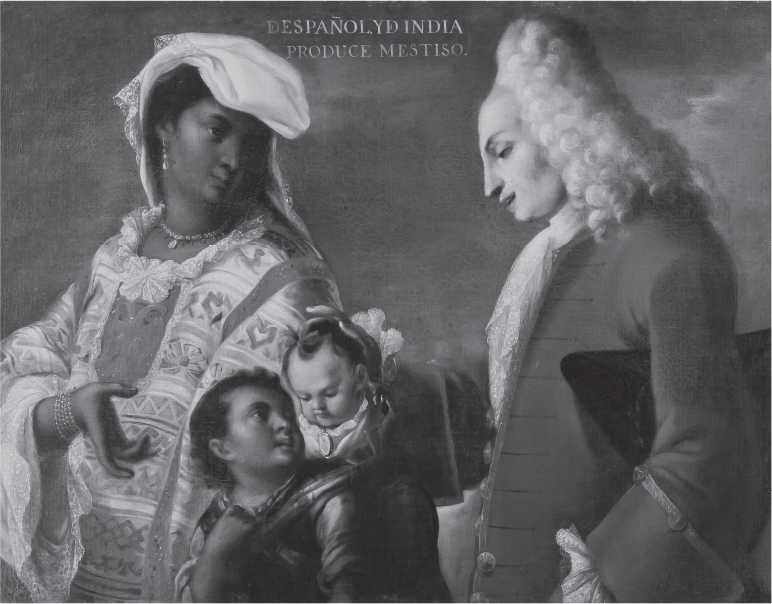
Figure 16
34.When this work was painted, it was not considered a work of art but rather
(A)the work of an illustrator
(B)a work of anthropology
(C)an illustration for a textbook
(D)a model for a future sculpture
35.The idea of mixed races, seen here, is also seen in the work of
(A)Wifredo Lam
(B)Pablo Picasso
(C)Frida Kahlo
(D)Wangechi Mutu
36.One can tell that this work was done by a European artist because
(A)it is done in fresco, a time-honored tradition in Europe
(B)it uses a mixture of experimental painting techniques
(C)it is life-size
(D)the artist uses the established oil-on-canvas technique
Question 37 is based on Figure 17.
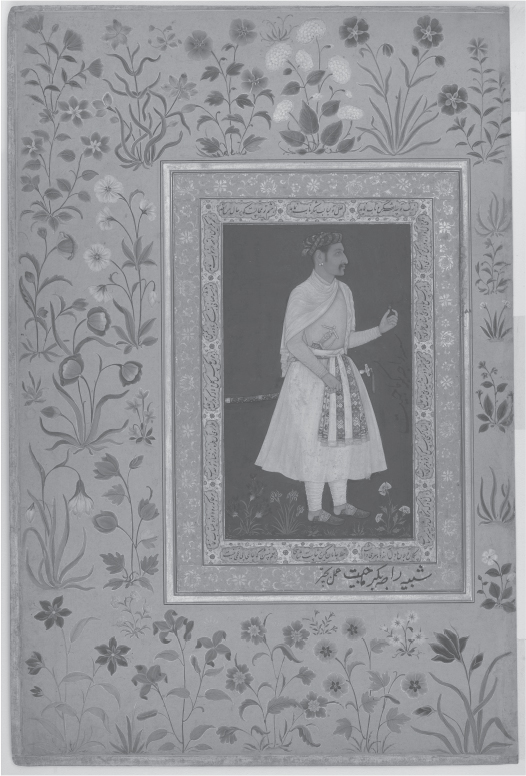
Figure 17
37.This work can be attributed to
(A)Sultan Mohammad
(B)Bichitr
(C)Ogata Korin
(D)Muhammad ibn al-Zain

38.Characteristics of the Islamic architectural aesthetic include
(A)flying buttresses that support a tall roof line
(B)the use of windowless interiors, which lend a sense of mystery
(C)thin columns that render a sense of weightlessness
(D)interiors with a dominant central focus sweeping the eye to an altar
39.The Hudson River School was
(A)set up to train New York artists
(B)a school of arts and crafts
(C)a group of landscape painters
(D)closed during World War II by the Nazis
Questions 40 and 41 are based on Figure 18.
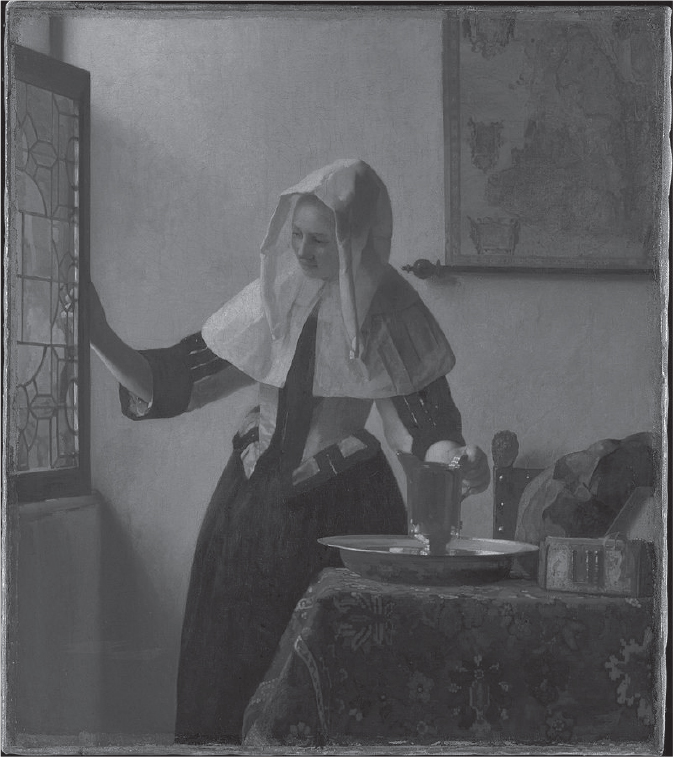
Figure 18
40.On the basis of style, this work can be attributed to
(A)Johannes Vermeer
(B)Peter Paul Rubens
(C)Rembrandt van Rijn
(D)Rachel Ruysch
41.This work shows the artist’s interest in depicting
(A)a satire on contemporary life
(B)the drudgery of working-class people’s lives
(C)the religious symbolism behind everyday events
(D)a person caught in a moment in time

42.One of the important aspects of Jeff Koons’s work is that he
(A)explores Old Testament themes in the context of modern cultures
(B)uses advanced photographic processes to create an alternate reality
(C)advocates for political change through his work
(D)creates a permanent reality out of something that is ephemeral and never meant to be exhibited
43.Painters interested in the sublime characteristically
(A)saluted the achievements of the Industrial Revolution
(B)were impressed by the opulence of the court of Louis XIV
(C)reveled in the realm of geometric precision
(D)had a religious reverence for landscape
Questions 44–46 are based on Figure 19.
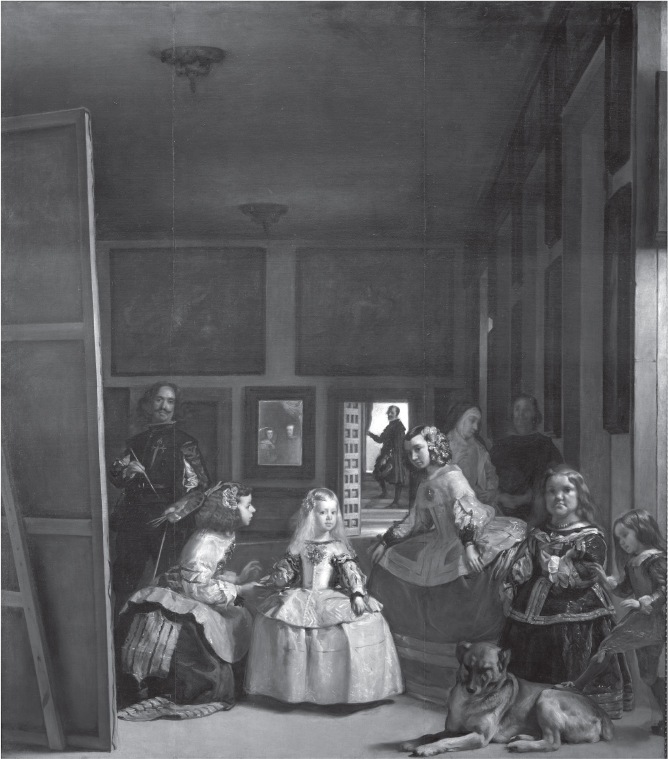
Figure 19
44.This painting seeks to elevate the occupation of the painter and declare it a noble calling. Velázquez wears the Order of Santiago, an expression of knighthood. Also symbolizing this noble calling is
(A)the dog who keeps watch over the royal household and symbolizes fidelity
(B)the paintings on the far wall that depict Minerva, goddess of wisdom and patroness of the arts
(C)the use of dark passages in the painting to signal a deep recession into space
(D)the heavenly glow cast around Velázquez
45.The original placement of this painting was
(A)in the Prado Museum in Madrid, showing a willingness to be compared to great Spanish painters of the past
(B)in the cathedral in Madrid, indicating a desire to find acceptance with the Catholic Church
(C)in the study of King Philip IV, challenging him to consider the multitude of interpretations the painting represents
(D)in the reception room at the Royal Palace in Madrid, where the portraits of the royal family would be viewable by visiting dignitaries
46.The title of the painting refers to
(A)the chaperones on the right, who are in half-shadow in the background
(B)the attendants to the princess in the foreground
(C)the king and queen, seen in the reflected mirror
(D)the dwarf and the midget in the right foreground
47.The Great Altar of Zeus and Athena at Pergamon depicts the battle between the gods and the giants, but also symbolically represents the
(A)building of the Acropolis
(B)rise of Greek power under Alexander the Great
(C)Greek defeat of the Persians
(D)Roman defeat of the Greeks
48.The sibyls on the Sistine Ceiling are meant to
(A)align Christian belief with classical allusions
(B)validate pagan beliefs to a nonbelieving audience
(C)make the imagery reach across religious boundaries and incorporate all faiths
(D)show the equality of Old and New Testament themes
Question 49 is based on Figure 20.
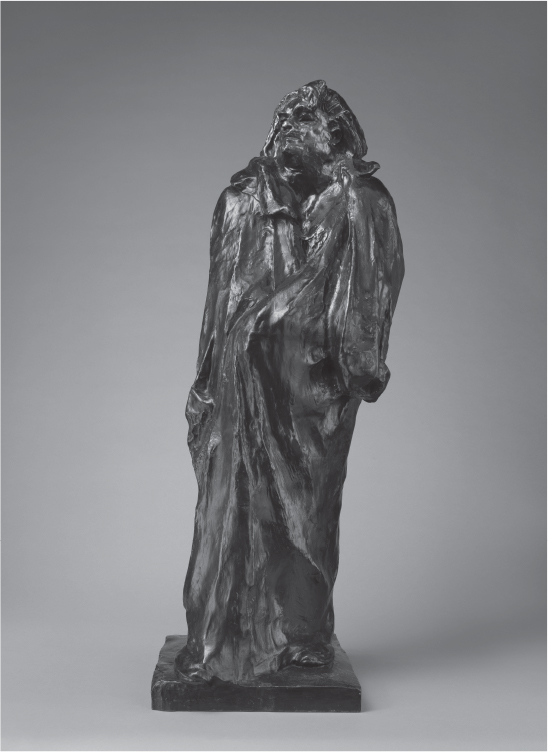
Figure 20
49.On the basis of style, this work can be attributed to
(A)Donatello
(B)Auguste Rodin
(C)Constantin Brancusi
(D)Jean-Antoine Houdon

50.Alfred Stieglitz’s photograph The Steerage shows the impact of
(A)Surrealism in its grouping of unalike images in one composition
(B)Cubism in its angles and planes intersecting at odd points
(C)Dada in its understanding of the foolishness and helplessness of the situation
(D)Expressionism in its jarring use of brutal forms
Question 51 is based on Figure 21.

Figure 21
51.The work in Figure 21 shows the influence of Western art in its use of
(A)classical contrapposto
(B)atmospheric perspective
(C)di sotto in sù
(D)tenebrism

52.The artwork of Emily Kame Kngwarreye is often inspired by
(A)references to objects in popular culture
(B)multimedia artwork
(C)commentary on contemporary political issues
(D)the dump-dot technique of paint application
Questions 53–55 are based on Figure 22.
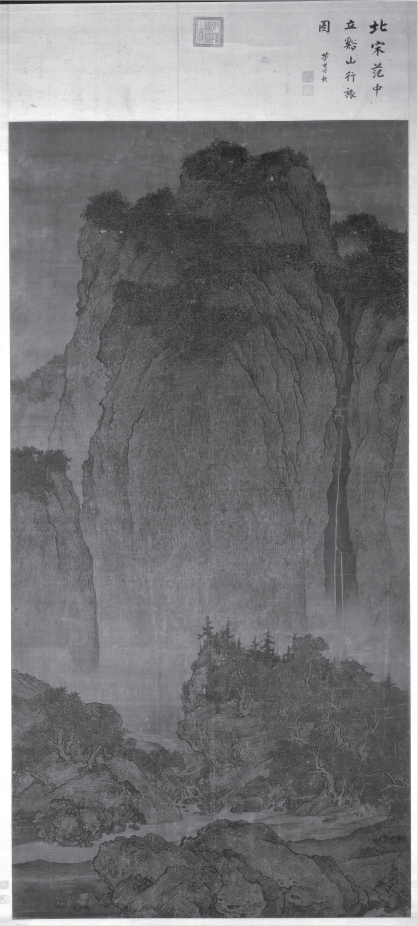
Figure 22
53.The landscapes of Fan Kuan, as seen in Figure 22, depict a
(A)strong relationship between European and Asian art forms
(B)complex interweaving of Buddhist and Confucian thought
(C)reflection of Daoist philosophy and teachings
(D)connection between Japanese and Chinese painting
54.The painting shown in Figure 22 can best be described as
(A)an image that depicts the struggle against the forces of nature
(B)one in a series of works that narrates the story of humanity’s civilizing effect on nature
(C)a work that shows how people can dominate their environment
(D)people and nature living together in a harmonized universe
55.Brush effects are achieved by using techniques involving
(A)classical composure
(B)ink washes for special effects
(C)tenebroso
(D)the introduction of tempera paint into China
Questions 56–58 are based on Figures 23 and 24.
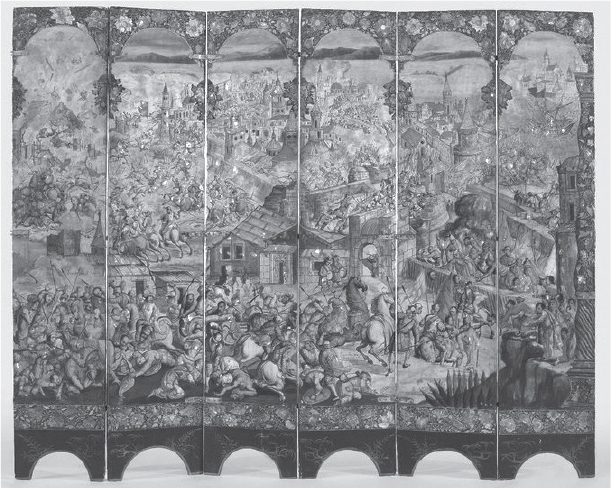
Figure 23
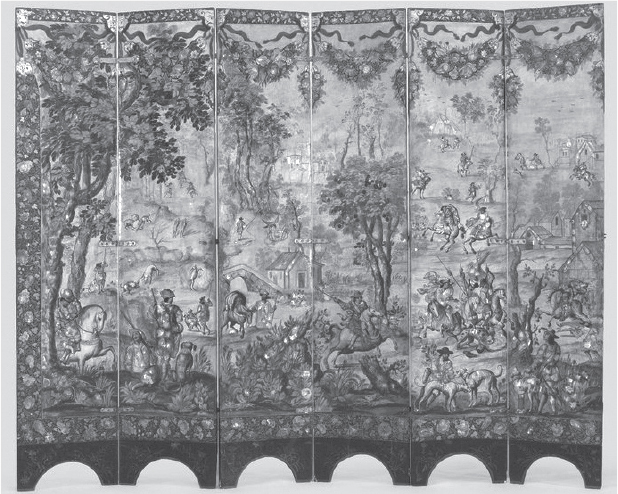
Figure 24
56.This screen has two sides, one showing a war scene and another showing a hunt. The war scene was meant to
(A)display Habsburg’s power
(B)illustrate Mexican military victories
(C)encourage people to enlist in the army
(D)offer peace as an alternative to war
57.The hunting scene is meant for
(A)grand rooms with large receptions
(B)display of cultural artifacts
(C)more intimate spaces
(D)showing trophies of the hunt, like firearms and stuffed animal heads
58.This work contains enconchados, which are
(A)freestanding screens
(B)paintings that show people of mixed descent
(C)shell inlay mother-of-pearl fragments
(D)techniques imported from Europe and given a new expression in Mexico

59.The terra cotta fragment from the Solomon Islands shows the characteristic use of
(A)stamped patterns of circles and dots
(B)cross-hatching to build up forms
(C)realistic human anatomy
(D)painted and sculpted figures
Question 60 is based on Figure 25.

Figure 25
60.Based on the content and style of this work, it can be determined that it is one of a series of works called
(A)The Disasters of War
(B)Marriage à la Mode
(C)casta paintings
(D)The French Collection, Part 1

61.Shirin Neshat’s photographs from the Women of Allah series challenge the viewer to
(A)accept the reality that Iranian women will defend their faith
(B)determine whether or not women clothed like this are treated as sexual objects
(C)agree that Iranian women have their rights taken from them by an oppressive male-dominated society
(D)understand women from both the Western and Iranian points of view
62.The catacombs in Rome were built to
(A)bury the dead in underground tombs because land prices were too high in Rome for above ground burials
(B)hide Christians from Roman persecutions in the second and third centuries
(C)provide space for the burial of Roman emperors during times of crisis
(D)hide the Roman artwork from the barbarian invasions
63.In which period did artists consistently paint sculpture?
(A)Renaissance
(B)Mannerism
(C)Neoclassicism
(D)Gothic
64.Kufic script is an Islamic form of writing that is
(A)unusually read from left to right
(B)very angular with the uprights at right angles to the baselines
(C)flowing, having a curved and running look
(D)found only on holy vessels and holy books
65.William Hogarth’s works often contain narrative elements
(A)taken from ancient myths and Biblical subjects
(B)which underscore a satire of the King of England
(C)illustrating stories taken from preexisting plays
(D)which are generally seen in large-scale individual portraits done in the Grand Style
66.Monticello is influenced by European models although it
(A)shows evidence of American Indian motifs
(B)is made from local materials
(C)references the African-American experience
(D)is daring in its use of metal in its substructure
67.Gestures in Caravaggio’s Calling of Saint Matthew are appropriated from the works of
(A)Raphael
(B)Leonardo da Vinci
(C)Michelangelo
(D)Pontormo
68.The Forbidden City is a highly expanded version of a Chinese architectural format called
(A)the courtyard style residence
(B)an axial plan
(C)a central plan
(D)a hypostyle hall
69.Dry Japanese gardens
(A)serve as centers for tea ceremonies
(B)symbolically represent the formations found in nature
(C)are modeled on landscapes depicted in hanging and hand scrolls
(D)are built to complement adjacent wet gardens
Questions 70 and 71 are based on Figure 26.
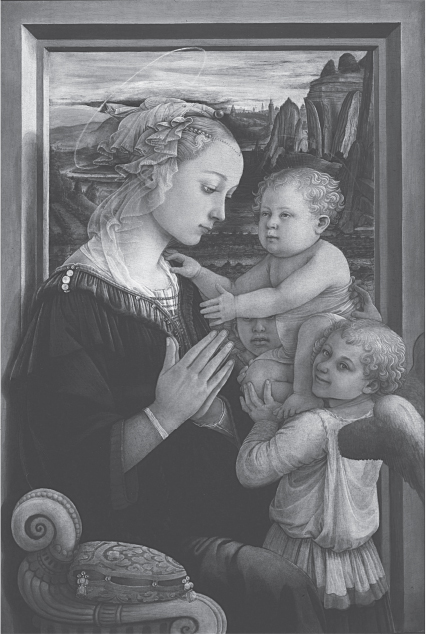
Figure 26
70.Realistic details set this work in
(A)the home of a Medici prince with a view of his estates
(B)a Florentine home with a view of the Arno valley
(C)a monastery with a view of its extensive grounds
(D)an orphanage with a view of an Alpine landscape
71.This painting is by
(A)Donatello
(B)Leonardo da Vinci
(C)Sandro Botticelli
(D)Fra Filippo Lippi
Question 72 is based on Figure 27.
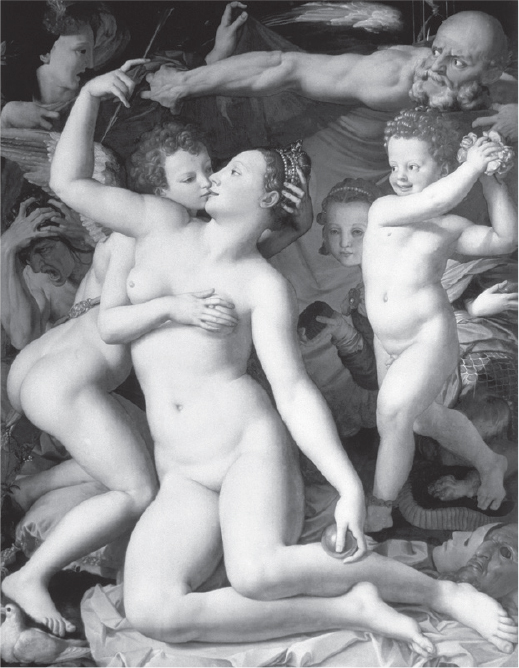
Figure 27
72.This painting can be attributed to a follower of Pontormo based on which characteristic?
(A)Use of tenebrism
(B)Elongated figures
(C)Pyramidal composition
(D)Stress on great emotions

73.Chokwe masks show a matriarchal society in African culture by having
(A)women wear masks that call upon their status in African culture
(B)women perform rituals wearing masks that identify their ancestors
(C)men wear masks and perform dances in which they move like a woman
(D)women wear male masks that depict male ancestors
74.A basic building technique of African architecture involves using a toron, which is used in buildings like
(A)Great Zimbabwe, which is constructed of ashlar masonry
(B)Great Zimbabwe, which needs vertical supports to frame the structure during construction
(C)the Great Mosque at Djenne, which is made of adobe
(D)the Great Mosque at Djenne, which is composed of a complex of buildings
75.The mosque at Córdoba is similar to many other mosques in that it
(A)contains radiating chapels for the placement of relics
(B)has a hypostyle hall that contains a myriad of columns
(C)is domed over the central area to indicate the direction to Mecca
(D)rejects the use of the axial plan and uses the central plan in its design
Questions 76 and 77 are based on Figure 28.
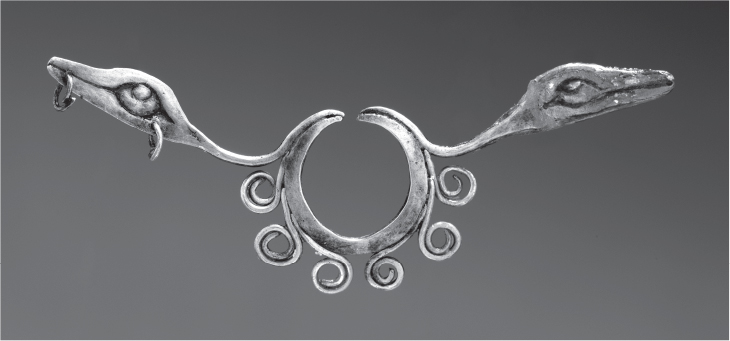
Figure 28
76.When this nose ornament is worn during ceremonies
(A)it turns the wearer into a supernatural being
(B)it symbolizes the wearer’s royalty and power
(C)it gives the wearer the power of the snakes depicted on both ends
(D)it indicates the mortality of the wearer and his or her eventual death
77.This ornament indicates
(A)the reciprocal relationship between the native Chavín religion and the growth of large-scale metalwork
(B)how oracles used metal as a sacred object to predict future events
(C)that pilgrimages to sacred sites necessitate the development of metal objects for veneration
(D)that people in the Chavín region were buried only with their most precious objects to be presented in the afterlife to the gods

78.Navigation charts used in the Marshall Islands are characterized by
(A)their practical use at sea
(B)the labeling of distant features in Micronesian script
(C)their diagonal lines, which represent wind and sea currents
(D)their bright paint, which made the formations clearer to read
79.A traditional symbol of Saint Luke, as seen in the Lindisfarne Gospels and elsewhere, is a calf, which symbolizes the
(A)pastoral nature of Saint Luke’s gospel
(B)sacrificial nature of Saint Luke’s gospel
(C)powerful and strong message of Saint Luke’s gospel
(D)determination of Saint Luke to write the gospels down as accurately as possible
80.Which of the following aspects of medieval Christian beliefs is reflected in the tympanum of Sainte-Foy at Conques?
(A)Sainte-Foy will judge sinners at the end of time.
(B)Each sinner will have his or her soul weighed and cast into purgatory.
(C)Each sinner has the ability to be saved through devotion and righteous living.
(D)The priests will determine who goes to heaven or hell in the afterlife.
SECTION II
TIME: 2 HOURS
6 QUESTIONS
DIRECTIONS: You have two hours to answer the six questions in this section.
Questions 1 and 2 are long essay questions, and you are advised to spend one hour on both.
Questions 3 through 6 are short essay questions, and you are advised to spend 15 minutes on each.
During the actual exam, the proctor will announce when each question’s time limit has been reached, but you may proceed freely from one question to another.
Some of the questions refer to images; some do not.
Read the questions carefully. You can receive full credit only by directly answering all aspects of the question.
Question 1: 35 minutes suggested time
This work is The Horse in Motion by Eadward Muybridge. It is an albumen print from 1878.

This work depicts a horse and a man in motion.
Select and identify another work of art in which the artist has depicted someone or something in motion. You may choose a work from the list below or any other relevant work.
For both The Horse in Motion and your selected work, describe the effect the artist is trying to render by imitating motion in a two-dimensional object.
Discuss the method or technique that these artists used to create the illusion of movement in each work.
Discuss how the method used by each artist renders a different result.
Explain at least one difference in the method in which each work communicates motion.
The Crossing
Nadar Raising Photography to the Height of Art
The Swing (after Fragonard)
Question 2: 25 minutes suggested time
Many works of art represent scenes of everyday life. Sometimes these works also reflect on the world at large.
Select and completely identify a work of art from the list below, or any other relevant work that reflects everyday life as a commentary on contemporary society.
Explain how the artist used imagery, symbolism, materials, and/or techniques to express this commentary.
In your answer, make sure to:
■Accurately identify the work you have chosen with at least two identifiers beyond those given.
■Respond to the question with an art historically defensible thesis statement.
■Support your claim with at least two examples of visual and/or contextual evidence.
■Explain how the evidence that you have supplied supports your thesis.
■Use your evidence to corroborate or modify your thesis.
No Crying Allowed in the Barbershop
Hunters in the Snow
Woman Holding a Balance
Question 3: 15 minutes suggested time
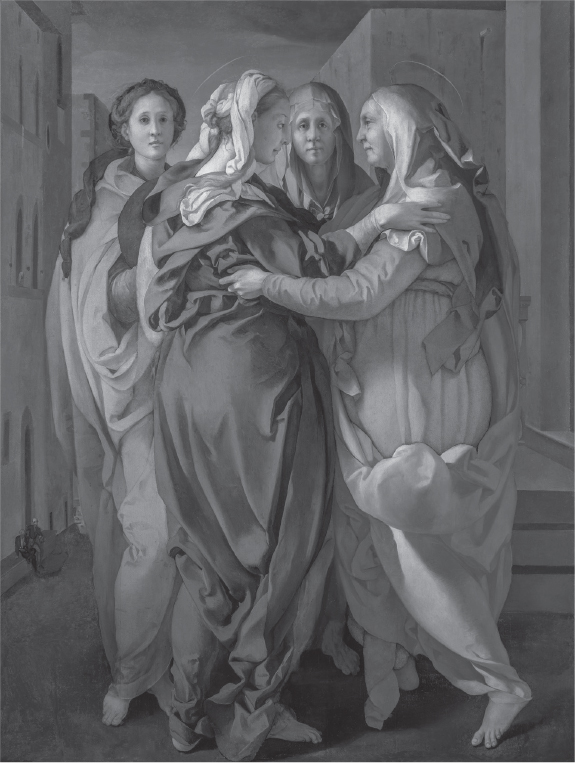
The work shown is The Visitation by Pontormo painted in 1528–1529.
What period in art history is this painting and this artist associated with?
Using at least two examples of visual evidence, discuss how elements of Pontormo’s style can be seen in this work.
Using at least two examples of visual evidence, discuss how Pontormo’s style represents a change from the art of the High Renaissance.
Question 4: 15 minutes suggested time
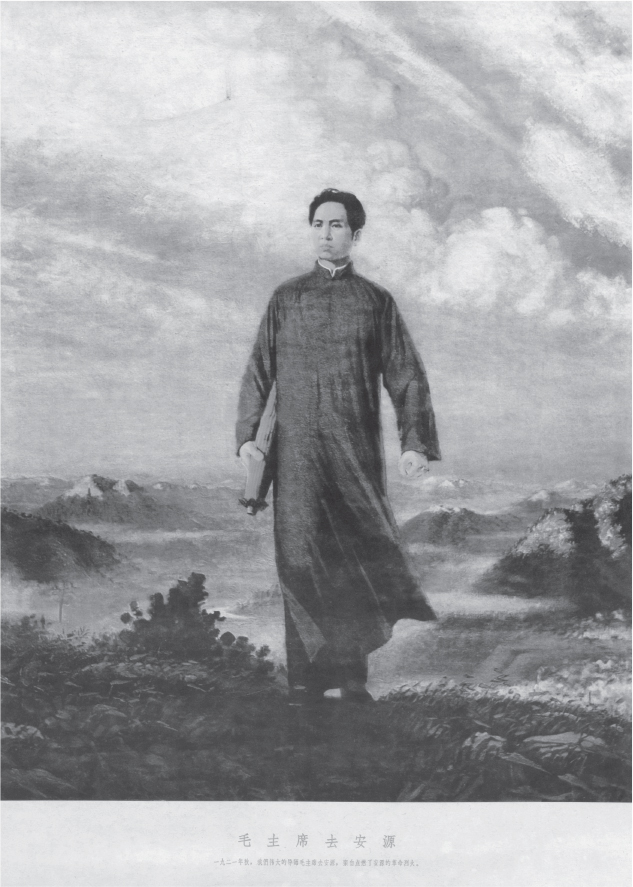
This work is Chairman Mao en Route to Anyuan, a color lithograph from 1969.
Describe the historical context for this work.
Using at least two examples of contextual and/or visual evidence, discuss how the context of this work has influenced the depiction and imagery of Chairman Mao.
Using at least two examples, explain how this work shows evidence of western art historical techniques.
Question 5: 15 minutes suggested time
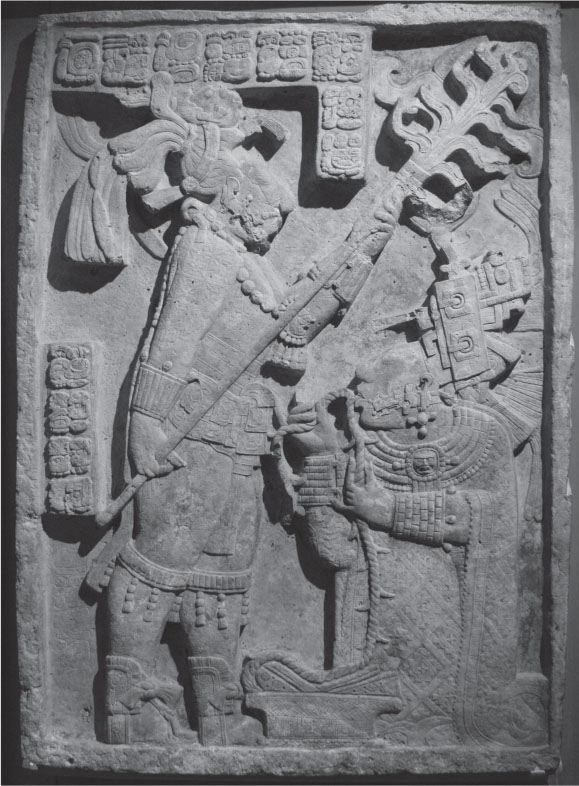
Attribute this sculpture to the culture that produced it.
Using at least two specific details, justify your attribution by describing relevant similarities between this work and a work in the required course content.
Discuss where sculptures such as this were likely to be placed, and what ceremony is likely being depicted here.
Question 6: 15 minutes suggested time
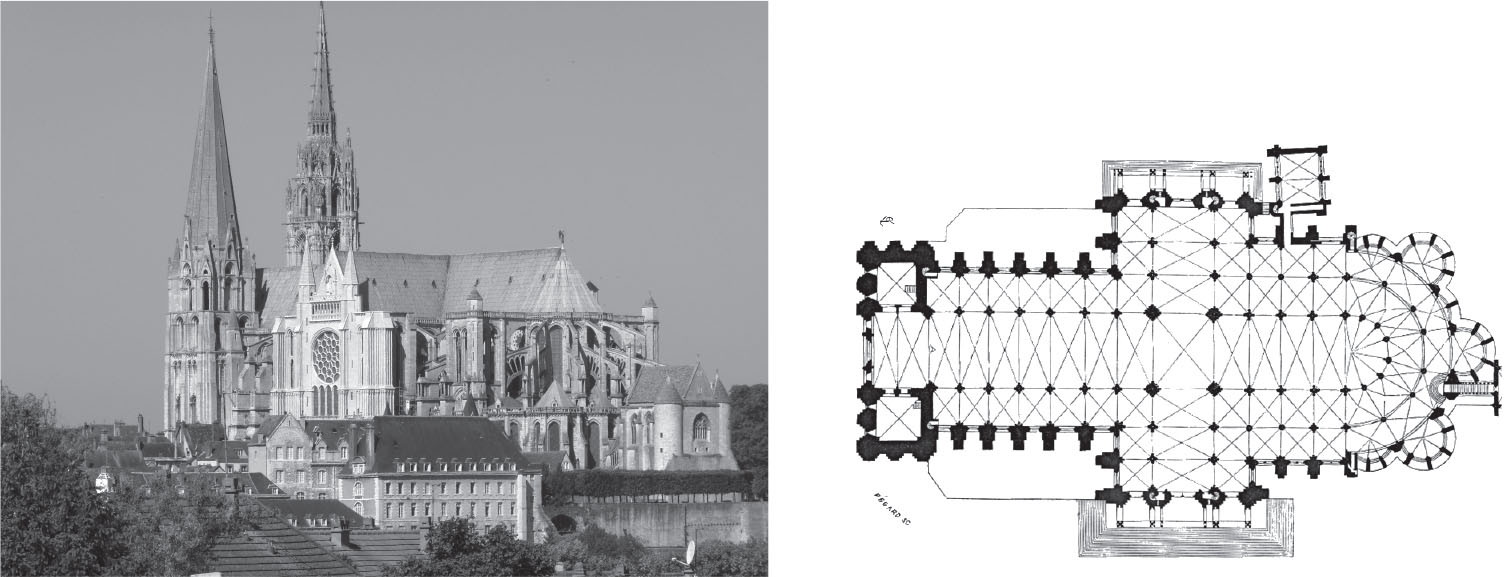
This is a photograph and a ground plan of the cathedral of Chartres, located in Chartres, France. It was begun in 1145 and reconstructed beginning in 1194.
Describe at least two materials or techniques used in the construction of this building or of the works contained within.
Describe how the architectural features of Chartres Cathedral continue the tradition of Christian church architecture.
Describe the innovative architectural features of the cathedral of Chartres and why those features represent a change from past church construction.
| ANSWER KEY |
| Practice Test 1 |
|
Section I 1. D 2. A 3. D 4. A 5. D 6. A 7. D 8. A 9. D 10. B 11. B 12. C 13. C 14. A 15. B 16. D 17. B 18. C 19. D 20. D 21. B 22. C 23. A 24. D 25. D 26. D 27. D 28. A 29. A 30. D 31. A 32. D 33. B 34. B 35. A 36. D 37. B 38. C 39. C 40. A 41. D 42. D 43. D 44. B 45. C 46. B 47. C 48. A 49. B 50. B 51. B 52. D 53. C 54. D 55. B 56. A 57. C 58. C 59. A 60. B 61. D 62. A 63. D 64. B 65. C 66. B 67. C 68. A 69. B 70. B 71. D 72. B 73. C 74. C 75. B 76. A 77. A 78. C 79. B 80. C |
Section I
1.(D) Bernini wrote plays, designed their stage settings, and built the theaters they took place in.
2.(A) The emotional realism seen in Bernini’s work is inspired by Greek works from the Hellenistic period, such as the Winged Victory of Samothrace.
3.(D) There are eight portraits visible on the sides of the main sculptural group. These are portraits of the donors, the Cornaro family.
4.(A) Jacques-Louis David is the foremost exponent of the Neoclassical style, as can be seen by the adherence to classical values of composition, form, and figure style.
5.(D) The Oath of the Horatii references an episode from a Roman legend.
6.(A) The Roman legend of the Horatii has a moral reference to sacrificing one’s self for the betterment of one’s country.
7.(D) Traditional wood-block printing is a Chinese specialty.
8.(A) The artist has declared that the characters in his work have no meaning.
9.(D) The multiplicity of forms is inspired by mass production.
10.(B) Because the Communist government could not read the meaningless inscriptions in this work, they thought it was subversive.
11.(B) The heroic nature of this imposing figure with its emphasis on nudity places it firmly within the Imperial Roman era. Egyptian and Persian works would have found nudity debasing, and Archaic Greek works do not have the contrapposto displayed here.
12.(C) The Basilica of Ulpia has the same long nave that leads to a focal point. The other buildings do not.
13.(C) Spolia are the reused elements from older architectural monuments.
14.(A) The building is a basilica whose focus is on the apse.
15.(B) Worshippers in this building are Christians; they pray congregationally, facing a common point where the priest stands.
16.(D) This a minaret located in Iraq. It originally functioned as a tower to call people to prayer, and was attached to a mosque, which is now in a ruined state.
17.(B) The agora had many functions, among the most prominent of which was to conduct state and financial business.
18.(C) The Panathenaic Way was used for several occasions, the most important of which were the sacred processions.
19.(D) A stoa is a commercial center that conducts business and commerce.
20.(D) Since the Panathenaic Procession depicts the movement of presentation goods to a given point, it resembles the Presentation of Fijian mats, which directs gifts to a monarch, in this case Elizabeth II of England.
21.(B) Renaissance architecture can be characterized by its balance, symmetry, and harmonious proportions. Both of these buildings have these characteristics. Although the Pazzi Chapel is associated with the building next to it, Santa Croce, the Palazzo Rucellai is not dependent on its neighbors. Neither uses flying buttresses. Each building has a different patron.
22.(C) Greek gods often contended with one another for dominance. The pediment of the Parthenon illustrates how Athena and Poseidon both vied to be the representative god for Athens.
23.(A) Pilgrims worship at the Great Stupa at Sanchi by praying while walking clockwise in the direction of the sun’s course.
24.(D) The centrally planned San Vitale resembles the central plan of the Pantheon in Rome.
25.(D) Angkor Wat was designed reflecting a mix of Hindu and Buddhist beliefs.
26.(D) Nan Madol was built, in part, to bring together nobles in one place.
27.(D) The exterior walls are built out into a lagoon and act as a breakwater for the complex.
28.(A) Not many Polynesian buildings are built of stone. This is unusual.
29.(A) Japanese prints are traditionally made in a woodblock printing technique. This work is from the Hokusai series called Thirty-six Views of Mount Fuji.
30.(D) Ukiyo-e is a Japanese tradition of genre painting that shows scenes of everyday life, in this case in the shadow of Mount Fuji. The other choices are all Japanese in derivation, but represent different aspects of Japanese art. Zen is a metaphysical branch of Japanese Buddhism. Yamato-e is a style of Japanese painting depicting episodes from Japanese history and literature and usually is seen on scrolls. Tarashikomi is a painting technique that shows paint applied to a surface before it has had a chance to dry from a previous application.
31.(A) Ndop sculptures are always depicted as uninvolved, above mortal affairs. They are celebrated only by the Kuba people, not throughout Africa. The anatomical proportions emphasize the head, not the feet. They are not wearing elaborate costumes but are often nude from the waist up.
32.(D) The extravagant costuming symbolizes the king’s wealth and power.
33.(B) The Ndop sculptures represent an aspect of Kuba culture that is still active today.
34.(B) These works were considered an example of cultural anthropology, as illustrations of the caste system in the New World.
35.(A) Wifredo Lam often incorporates elements of Hispanic and African culture in his works.
36.(D) Oil on canvas is a technique found only in European traditional painting. This is an oil-on-canvas work.
37.(B) This work is similar to Jahangir Preferring a Sufi Shaikh to Kings and is by Bichitr.
38.(C) Buildings like the Alhambra employ light, thin columns that create the illusion of weightlessness.
39.(C) The Hudson River School was not really a school in the traditional sense. It was a group of landscape artists who shared the same artistic philosophy.
40.(A) This work is by Johannes Vermeer and is very similar to Woman Holding a Balance.
41.(D) As an artist, Vermeer had no interest in satire or depicting everyday life as monotonous and boring. Although religious symbolism does occur in his works, this painting is more interested in capturing the sitter in a moment in time.
42.(D) Jeff Koons’s work, like the Pink Panther, creates a permanent reality out of something that is ephemeral and never meant to be exhibited.
43.(D) Painters interested in the sublime often had an appreciation for the awesome aspects of nature, as seen in The Slave Ship by Turner.
44.(B) The paintings on the far wall depict Minerva, the goddess of wisdom and patroness of the arts. There is a relationship expressed between the act of painting as a divinely sponsored act and King Philip as a divinely appointed monarch.
45.(C) The original placement of this painting was in the study of King Philip IV, challenging him to consider the multitude of interpretations the painting represents. Today it is in the Prado Museum in Madrid. It was never located in a cathedral and was painted before the building of the Royal Palace in Madrid.
46.(B) The title of the painting, Las Meninas, refers to the attendants to the princess in the foreground.
47.(C) Although the Pergamon Altar depicts the victory of the gods over the giants, it also references the Greeks as the gods and the Persians as the giants.
48.(A) The sibyls are Greek classical prophetesses who are aligned with Old Testament prophets on the Sistine Chapel ceiling.
49.(B) All of these artists are sculptors. Rodin is the correct response because of the way the bronze is treated, as if modeled in clay by hand. This tactile approach is a hallmark of Rodin’s art. This work does not have the smooth finish of Houdon or Brancusi, nor does it have the heroic nudity of Donatello.
50.(B) Stieglitz was heavily influenced by modernist European trends in painting, including the analytical nature of Cubism.
51.(B) The background of this painting shows the European technique of atmospheric perspective.
52.(D) The dump-dot technique uses the brush to pound the color into a canvas and create layers of color and the effect of movement. This is a specialty of Emily Kame Kngwarreye.
53.(C) Fan Kuan isolated himself away from civilization to be with nature, study nature, and engage in a Daoist philosophy.
54.(D) The people in the painting, although tiny, live in harmony with the landscape.
55.(B) Fan Kuan was noted for achieving special effects with his delicate ink washes.
56.(A) The war scene illustrates the Siege of Belgrade and victory for the Hapsburg troops in eastern Europe.
57.(C) The hunting scene is meant to face a more intimate environment.
58.(C) Enconchados are shell inlays made of mother-of-pearl.
59.(A) The terra cotta fragment from the Solomon Islands is marked with stamped patterns of circles and dots.
60.(B) This is the first work in a series called Marriage à la Mode by William Hogarth. The second work, The Tête à Tête, is in the required course content.
61.(D) Many of Neshat’s images can be interpreted as having a positive and negative message, depending on the viewer. Her work seeks to present both points of view.
62.(A) The catacombs were tombs, not refuges from persecution as tradition alleges. Emperors would not have been buried in such humble locations.
63.(D) Almost all Gothic sculpture, including the Royal Portals at Chartres and the Röttgen Pietà, were painted.
64.(B) Kufic script is noted for its angular forms, with direct uprights and perpendicular baselines.
65.(C) Marriage à la Mode is derived from a seventeenth-century play by John Dryden.
66.(B) Jefferson was strongly influenced by European design principals when he built Monticello, but the building is made from local materials found in the colonies.
67.(C) Caravaggio’s paintings often reference Michelangelo’s Sistine Ceiling, including Jesus’s gesture in the Calling of Saint Matthew, which comes from The Creation of Adam.
68.(A) The Forbidden City is a large version of a traditional Chinese courtyard style residence.
69.(B) Japanese dry gardens use materials such as stone, plants, and sand to symbolically represent formations found in nature. They don’t necessarily have wet gardens nearby.
70.(B) Lippi’s paintings often take sacred subjects, like the Madonna and Child, and place them in the context of an Italian home with a view of the Arno river valley in the distance.
71.(D) This painting is by Fra Filippo Lippi.
72.(B) This painting was done by Bronzino, a follower of Pontormo. Bronzino uses the same kind of elongated figures found in Pontormo’s work.
73.(C) Men wear Chokwe masks and ceremonially dance in imitation of a woman during rituals.
74.(C) Torons are used to hold the adobe walls of buildings like the Great Mosque at Djenne in place.
75.(B) The hypostyle hall at the mosque at Córdoba contains a myriad of columns. Radiating chapels is a characteristic of Christian Romanesque architecture. There are no domes at Córdoba, and the building is not on a centrally planned design.
76.(A) When this nose ornament is worn during ceremonies, it turns the wearer into a supernatural being.
77.(A) This ornament indicates the reciprocal relationship between the native Chavín religion and the growth of large-scale metalwork. There seems to be a direct link between the use of these precious metal objects and the development of Chavín religious practices.
78.(C) Navigation charts used in the Marshall Islands are characterized by their diagonal lines, which represent wind and sea currents.
79.(B) Many Christian stories deal with sacrifice. Saint Luke’s gospel is symbolized by a calf, a sacrificial animal.
80.(C) Each sinner has the ability to save himself or herself. The tympanum at Sainte-Foy acts as a cautionary tale, warning people to behave appropriately to assure a happy life in the next world.
Section II
MODEL RESPONSE FOR QUESTION 1
The second work showing motion, Nadar Raising Photography to the Height of Art by Honore Daumier, is a lithograph print created around 1860.
In The Horse in Motion, Eadweard Muybridge attempted to imitate the motion of a horse running in order to prove whether or not all four of a horse’s hooves leave the ground while it’s running. Muybridge was hired by a California governor (who was also the founder of Stanford) to settle a bet over this question, and was able to prove that all four hooves leave the ground by taking a rapid series of photographs that capture the changing position of the horse while it was moving and imitate its motion. The series of images was able to settle the bet and created the effect of the horse actually moving, which was like a precursor for film. In Nadar Raising Photography to the Height of Art, Daumier imitates motion in the print in order to comment on the controversy regarding photography as an art form in the 1860s in a humorous manner. He uses a cartoon like style to portray famous photographer Nadar in a hot air balloon being blown across the sky, the motion making his work seem dangerous and thrilling. The effect of portraying motion in the piece makes Nadar’s work seem more dangerous than it actually was (as he actually worked under calm conditions).
Muybridge took advantage of the technological developments of his time to take rapid photographs of the horse as well as develop them properly to create The Horse in Motion. The exposure time for images used to be much longer, but by Muybridge’s time the technology had reached the point where treated glass plates that required only a fraction of a second exposure to capture an image were available. The much faster exposure times as well as the invention of mechanical shutters allowing the camera to capture images faster allowed Muybridge to set up a series of cameras along the track where the horse was running and capture the series of images that made up this work. Daumier’s lithograph print Nadar Raising Photography to the Height of Art makes it seem like the hot air balloon, and therefore also Nadar and his camera, are moving by creating the illusion of strong winds in the image. The diagonal positioning of the hot air balloon’s ropes and basket make it appear as if strong winds are buffeting it. Billowing fabrics, such as Nadar’s clothes and the cloth on the basket, as well as the dangling rope and Nadar’s lost hat all add to the illusion of there being strong winds in the image. This wind creates the illusion of movement in the piece, as the both the balloon and Nadar are blown around.
The result of Muybridge’s method of imitating motion, a series of rapidly taken photographs of a horse during a short period of time, was a series of images that showed the animal’s motion over that time. The images together created the illusion that the horse was actually running. Although viewers of the still images can see and imagine the motion of the horse, this work as well as later similar ones by Muybridge paved the way for the future of cinema. It was later that the realization the images shown in rapid succession as well as the human eye’s persistence of vision (the eye continuing to see an image for a brief period despite it not being visible anymore) made it look like actual motion that let to filmmaking.
The result of Daumier’s method of imitating motion was an image that was able to comment on the status of photography as an art form at the time it was created. Regardless of the controversy over whether photography was a fine art or not, photography was growing in popularity, and the motion of the balloon soaring upwards in the print alluded to this. Additionally, the motion of the balloon made Nadar’s work seem more dangerous than it actually was and shows Nadar as so devoted to his art as to ignore the danger to himself.
One significant difference in the methods each work uses to communicate motion is that The Horse in Motion relies on a series of images to communicate the idea of motion. Each photograph seen individually is nothing more than a still image of a horse in mid motion. However, when seen together, the series of images creates the illusion of motion. Nadar Raising Photography to the Height of Art is a single image that communicates the idea of motion very differently. Daumier uses the composition of the image, strong diagonals and the placements of the hat and cloth, to show the strong wind which creates the illusion of motion in his piece.
—Clarisse C.
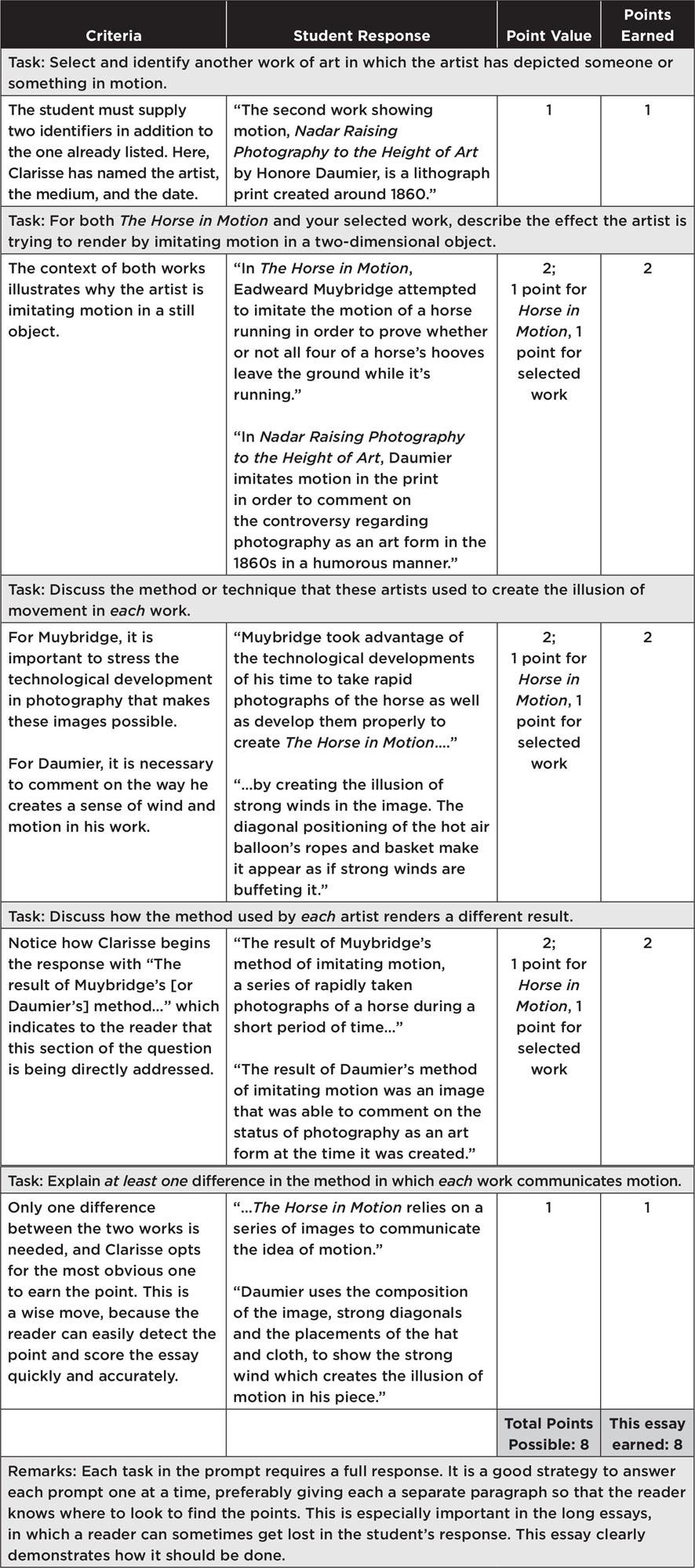
MODEL RESPONSE FOR QUESTION 2
No Crying Allowed in the Barbershop, created by Pepon Osorio, is an installation located in Hartford, Connecticut. The installation consists of repurposed objects such as television monitors, barbershop chairs and tools, photographs of Puerto Rican men, and products geared towards men (e.g. baseballs, protein supplements, certain hair products).
Osorio comments on the Puerto Rican culture of machismo and hypermasculinity by contrasting traditionally masculine settings, imagery, and products to imagery of men crying. The setting of a barbershop comes from Osorio’s own childhood memory. As a child he had been brought to the barbershop by his father, but when he began crying in fear of the electric razor, his father told him that no crying was allowed in the barbershop. This speaks volumes of what the barbershop represents as well as the expectations of Puerto Rican men in their community. The barbershop is meant to be a place exclusively for men and a boy coming in and getting his hair cut for the first time is a kind of coming of age. However, being told so early on not to cry while there shows the cultural expectation for men not to show outward emotions. The entire installation is filled with memorabilia and products representative of masculinity from the chairs and objects hanging on them to the framed photos on the wall. Each of these reflect what is expected of men. The monitors showing those of the community posing (often in more traditionally masculine poses like flexing) add to the atmosphere of a very masculine setting.
However, this is contrasted by the addition of the monitors of men crying. When being placed in such a setting, seeing this open vulnerability of men is intensified. Alone it would not have the same effect, but while placed in the cultural context of the barbershop and all that Osorio included inside it, the imagery speaks strongly of the issue of hypermasculinity and the effects of bottling up emotions and having to show oneself off as macho and strong.
—C.Z.
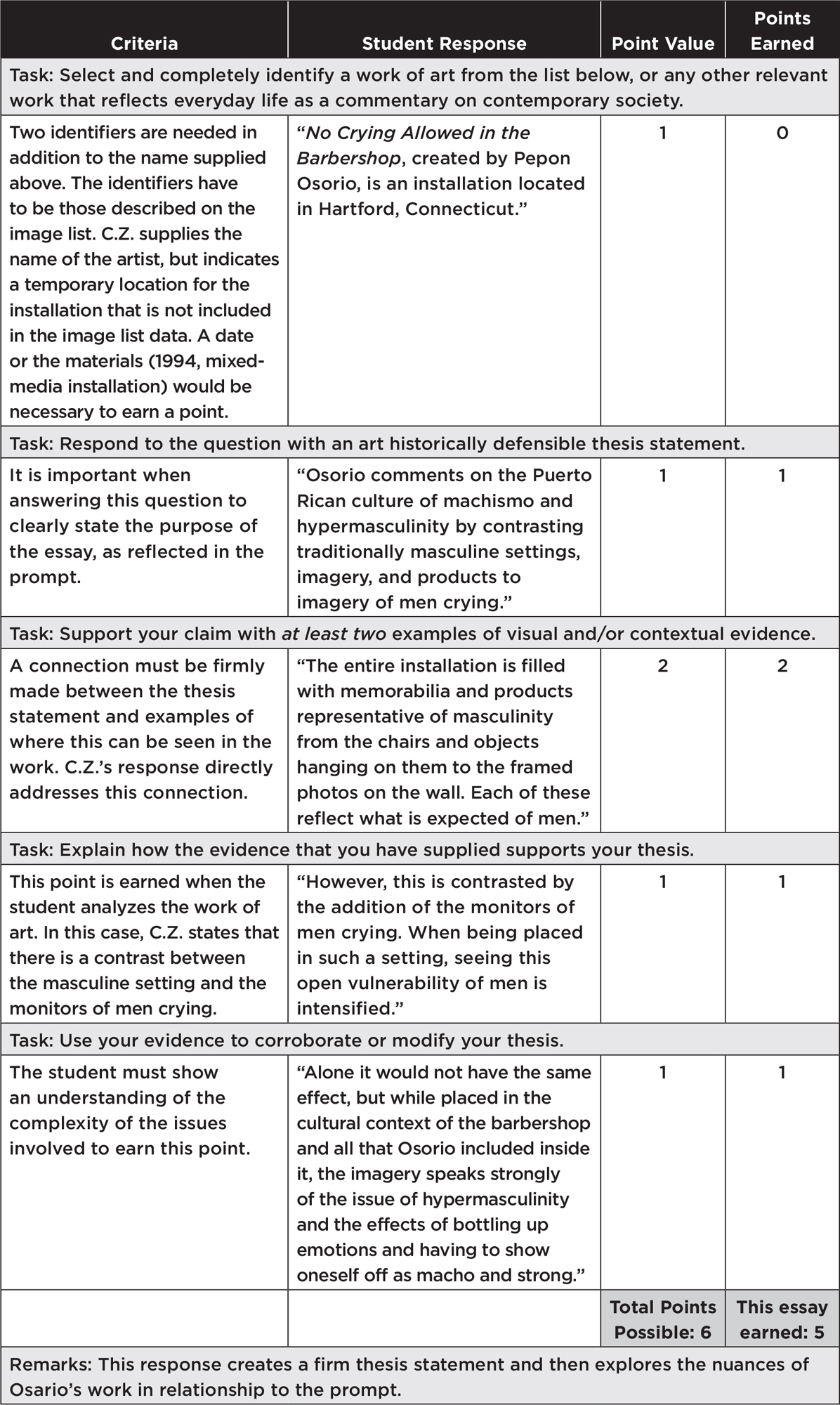
MODEL RESPONSE FOR QUESTION 3
This work is from the Mannerist period.
The first example of visual evidence showing elements of Pontormo’s style is his use of disproportionate figures. The heads of the figures are small compared to their ample bodies, and their floating feet look too small and delicate to support their frames. Pontormo also employs odd combinations of vivid colors, for example, orange and mint green. His use of non-complementary color combinations is also visible other work The Entombment of Christ.
The Mannerist period was a direct reaction to the High Renaissance period, and this painting shows a few visual examples of that. The first example is that the Renaissance painters heavily focused on symmetry and balance. Pontormo contradicts that by putting all the figures in the immediate foreground, and they are disproportionately spaced in relation to each other. Another example of the contrast between the two periods is that Renaissance painters often used linear perspective to create intricate and realistic backgrounds, but this work uses minimal linear perspective, shown in the buildings in the back. The buildings are plain and are painted with drab greys and blues, which keeps the focus on the foreground.
—Olivia B.
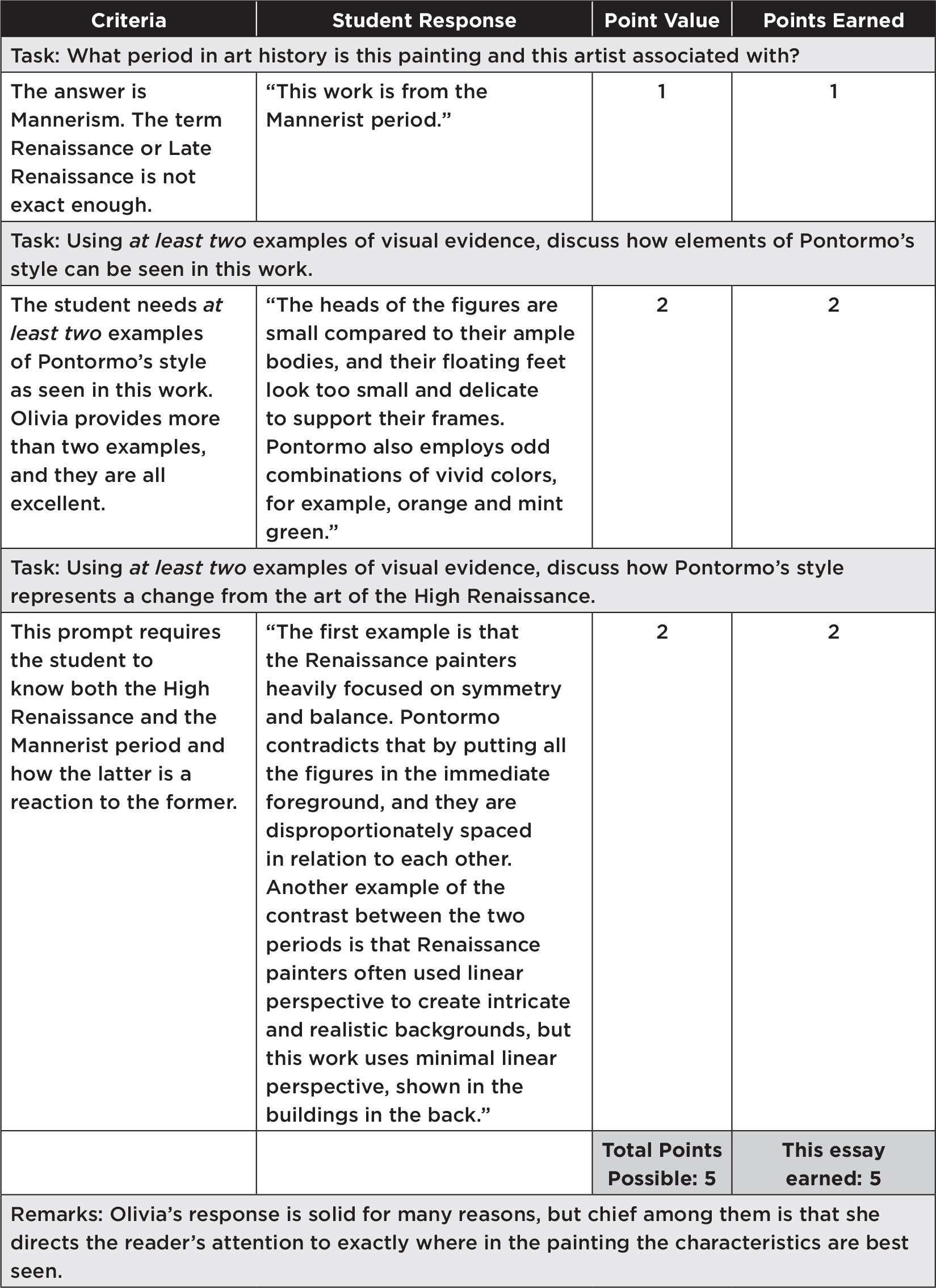
MODEL RESPONSE FOR QUESTION 4
This lithograph was painted during the emergence of China’s Cultural Revolution. In this era, the Chinese government aimed to rid China of any threat to their ideal of a communist government. This meant that millions of intellectuals, teachers, writers, etc.—any citizen who posed new ideas that challenged China’s inflexible communist objectives—were abused and/or executed by Mao’s “Red Guards.” In addition, artists that painted in traditional styles—styles prior to the age of China’s communism—were tyrannized as a result of the ideology of the Chinese government. In this work, Chairman Mao is marching towards Anyuan, a town where Mao spurred workers in a coal mine to revolt for better treatment. This revolt was successful in that Mao converted the mine workers to Communism, and that it commenced a revolution.
In this work, Chairman Mao is depicted as the ultimate Chinese leader committed to communist values. Mao is the main focus of the work. He struts unaided in the center of the lithograph, and is depicted as confidently marching over the vast rural Chinese landscape as he reacts in favor of the Chinese people. His eyes gaze far into the future as he holds his chin high. Mao’s left fist is tightly clenched, and his chest is proudly extended. He holds an old umbrella under his right arm, which displays his interconnectedness to the unadorned living to the Chinese middle class. Above the horizon, clouds roll back as the wind blows in Mao’s black hair; he is on the eve of an incendiary uproar.
This work shows evidence of western art techniques in a number of ways. The artist employs atmospheric perspective in the landscape that envelopes Chairman Mao. In addition, perspective is further emphasized by the shading on Mao’s traditional Chinese clothing. Both of these methods of depicting perspective are evident in Western Art.
—Owen M.
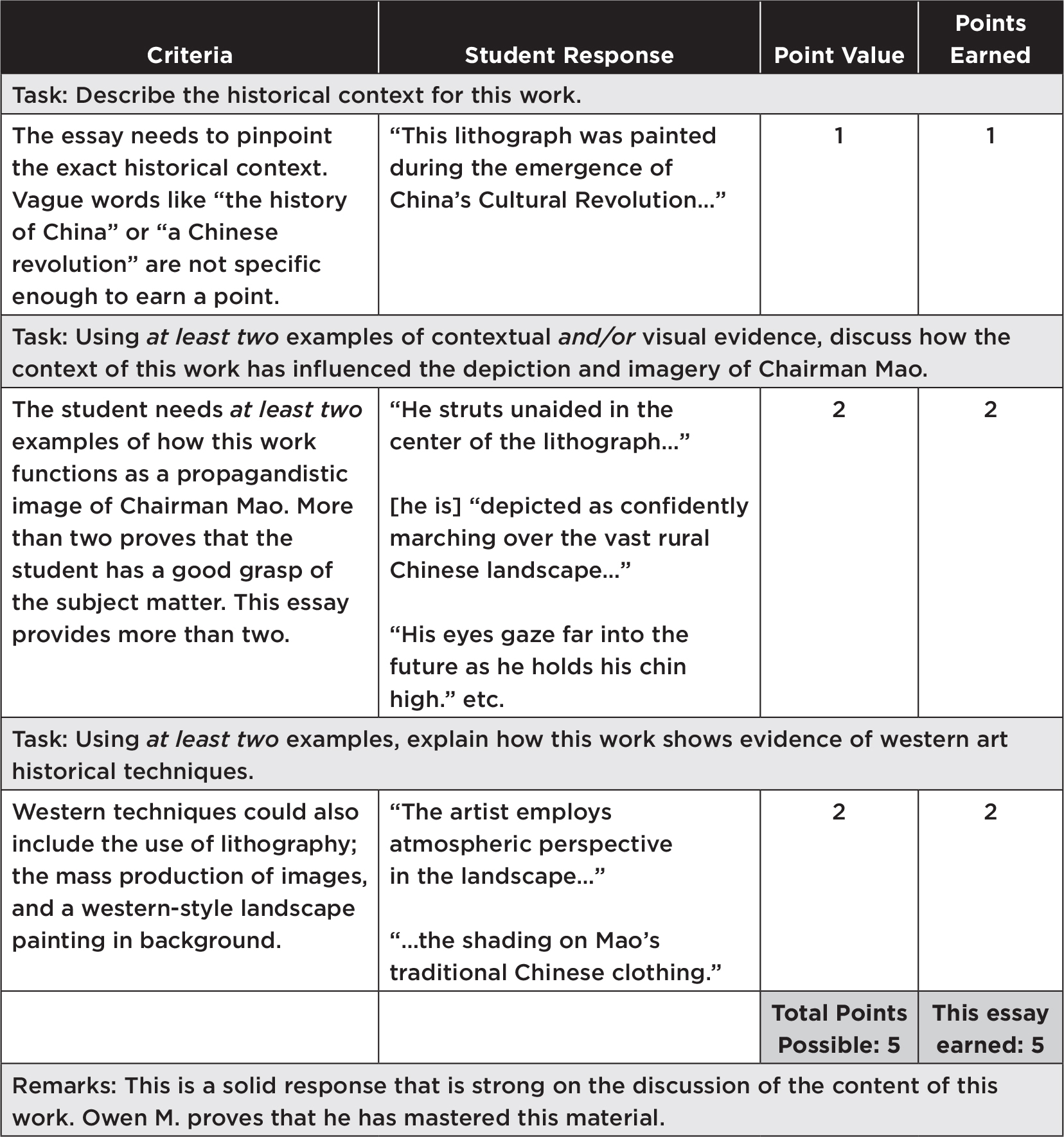
MODEL RESPONSE FOR QUESTION 5
This sculpture can be attributed to the Maya culture, since it is most similar to the Mayan work in our set being Yachilan, Lintel 25 Vision of Lady Xoc.
A specific detail that justifies my attribution are the lintels themselves, since in both cases, they have a flat background with the foreground literally popping out and they are framed by a thin edge and in both cases, are rectangular about twice as tall as they are long.
The content that is emphasized justifies my attribution as well. For example, in both lintels, the subjects are wearing large, ornate headpieces. Furthermore, in both lintels, hieroglyphs are embedded in the sculpture and they both feature a bowl-shaped object. Finally, a very specific resemblance in both the sculptures is that both feature one person holding a weapon who stands above another person who is not carrying a weapon, with both being ornately dressed.
This sculpture would likely be placed in a temple to the gods. The ceremony likely being depicted here is a bloodletting ceremony, performed for the gods, since the Maya believed that the gods sacrificed blood to make humans, so humans need to sacrifice blood to repay the gods. This can be seen since it depicts a person insert a rope with thorns into their mouth, so they can bleed and perhaps drip the blood into what appears to be a bloodletting bowl below his mouth. By losing blood, they would have the added benefit of having visions which are interpreted as messages from the gods.
—Hector C.

MODEL RESPONSE FOR QUESTION 6
Several new structural techniques used in the construction of the Chartres Cathedral include the ribbed groin vault, flying buttresses, pointed arches, and clerestory windows. The ribbed groin vault is supported by the pointed arches and flying buttresses, which carry the weight of the stone vaulting from the walls towards the ground, freeing the walls from their traditional role as the main structural support of the building. This technology enables the addition of clerestory stained glass windows, which allow light to permeate the interior of the church. This innovative support system also enables structures to be larger and more expansive, creating the church’s stunning sense of soaring verticality.
The Chartres Cathedral continues the tradition of Christian church architecture through several shared architectural features that reflect a similar basic floor plan. Traditional Christian church architecture was based upon a simple basilica plan. Churches were traditionally a basic rectangular shape with a nave, single aisle, apse with altar, and the eventual inclusion of a narthex. Though the Chartres Cathedral has a more complex floor plan with additional features, both the cathedral and traditional churches share a central nave, large interior space, clear focal point down towards the apse, and an altar at the apse.
The innovative architectural features of the pointed ribbed groin vault, flying buttresses, clerestory windows, and expanded architectural plan of the Chartres Cathedral represent a change from past church construction. The changes to the floor plan are the result of pilgrimage. Earlier church plans were not designed to accommodate the large number of pilgrims visiting churches to view relics. Radiating chapels were added to display relics, transepts were built for pilgrims to enter and exit the church without disturbing mass, and an ambulatory was added as a walkway to the radiating chapels. Early Christian churches also had wooden roofs, which frequently caught fire. Wooden roofs were replaced with Romanesque stone barrel vaults, which did not burn. However, the walls of Romanesque churches could not be permeated with windows because they bore the weight of the stone barrel vaulting, making the churches very dark. Abbot Suger called for architecture that would allow Lux Nova, the presence of God within light, to pour into the church. The innovative structural technology of the pointed ribbed groin vault and flying buttresses in the Chartres Cathedral replaced the inferior support system of the Romanesque round barrel vault, which required thick walls, piers, and solid buttresses. This new support system enabled clerestory stained glass windows, which allow light to pour into the cathedral.
—Haley J.
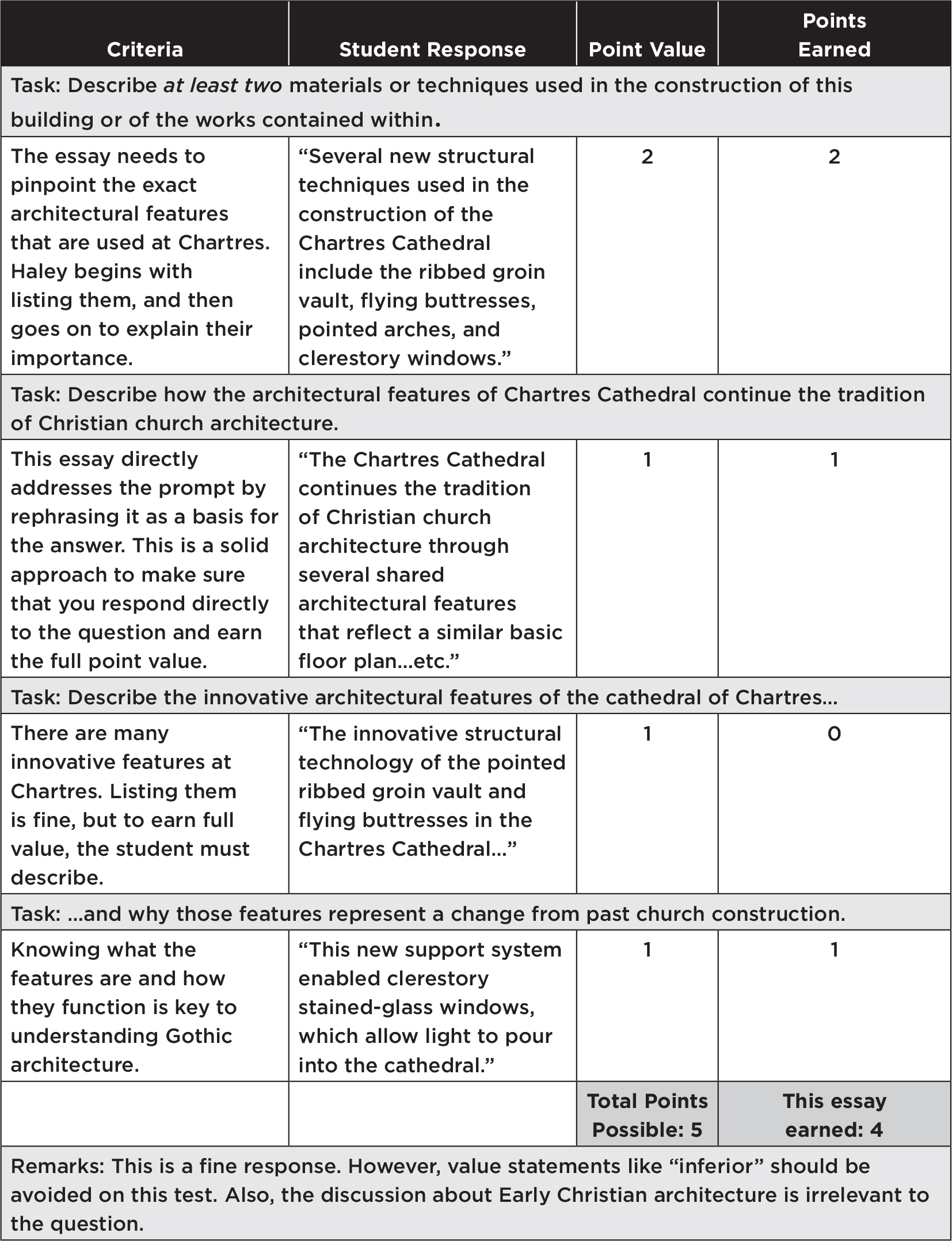
TEST ANALYSIS
NOTE: Because the AP Art History exam has been redesigned, there is no way of knowing exactly how the raw scores on the exams will translate into a 1, 2, 3, 4, or 5. The formula provided below is based on past commonly accepted standards for grading the AP Art History exam. Additionally, the score range corresponding to each grade varies from exam to exam, and thus the ranges provided below are approximate.
SECTION I: MULTIPLE-CHOICE (50% OF GRADE)

SECTION II: ESSAYS (50% OF GRADE)

FINAL SCORE

Final Score Range |
AP Score |
150–200 |
5 |
132–149 |
4 |
110–131 |
3 |
75–109 |
2 |
0–74 |
1 |